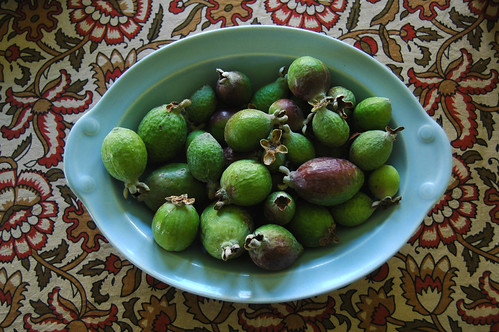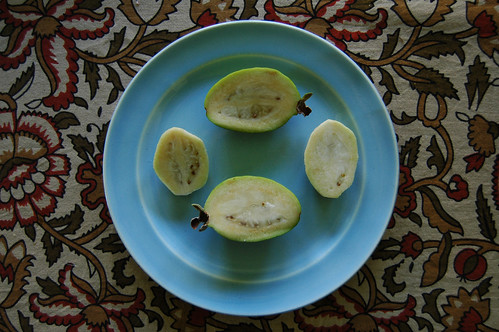Winter Foraging -- Pineapple Guava
...


photo from Bay View Elementary School's nutrition program
At this time last year, everyone at Berkeley Repertory Theater was in the middle of a huge upheaval. We'd bought a complex of buildings, had given up our leased spaces, and were racing to get moved in during a rare period of "down time." My scene shop didn't just move the contents of the eighteen thousand square foot warehouse. We also moved all of the systems. So, when the air-handling system was moved, and we had no heat, I knit hats for all of my staff. It was a hard and hectic time, but we got through it, and are now settled into our new workplace.
At the time of the move, I noticed some unusual fruit-looking objects laying on the sidewalk, outside of our new place. My brain was occupied with the thousand details of the move, and I told myself to stay focused and to keep moving.
The following spring, I noticed that the hedge that surrounded our complex was blooming. The flowers were like nothing I'd ever seen before. Fleshy and velvety and very exotic. Oddly, a few days after the flowers caught my eye, I saw them on a website about tropical fruits. Turns out, they were the flowers of the feijoa, otherwise known as the pineapple guava or guavasteen.
The flowers themselves are edible. Posh folks around here use them as a garnish in champagne. The local squirrels certainly loved to eat the flowers. I never failed to smile when I saw an urban squirrel munching on one of these crazy-looking blooms.

Now, the hedge has ripened, and I'm collecting these odd fruit before and after work. The fruit fall off the plant once they're ripened, and I have no shame about picking them up off the ground. (I wash them very carefully.)

The fruit has a texture like pear, and tastes like a cross between kiwi fruit, jolly rancher candies, and just a smidge of turpentine (actually, I meant kerosene -- whoops). They have an intoxicating perfumed fragrance that Robb finds disconcerting, but which I just love. They're smaller than a chicken's egg.
We eat them by cutting off the skins (which carry most of the solvent-y flavor) and eating the entire fruit. You can cut them in half and scoop out the pulp with a spoon. Delicious.

These fruits are native to South America, but grow very well in the San Francisco Bay area. I tasted several varieties at the most recent meeting of the California Rare Fruit Growers. They're not true guavas, but rather belong to the myrtle family. The shrubs are evergreen, and very attractive.

What about you? Have you ever tried these? What did you think?
At this time last year, everyone at Berkeley Repertory Theater was in the middle of a huge upheaval. We'd bought a complex of buildings, had given up our leased spaces, and were racing to get moved in during a rare period of "down time." My scene shop didn't just move the contents of the eighteen thousand square foot warehouse. We also moved all of the systems. So, when the air-handling system was moved, and we had no heat, I knit hats for all of my staff. It was a hard and hectic time, but we got through it, and are now settled into our new workplace.
At the time of the move, I noticed some unusual fruit-looking objects laying on the sidewalk, outside of our new place. My brain was occupied with the thousand details of the move, and I told myself to stay focused and to keep moving.
The following spring, I noticed that the hedge that surrounded our complex was blooming. The flowers were like nothing I'd ever seen before. Fleshy and velvety and very exotic. Oddly, a few days after the flowers caught my eye, I saw them on a website about tropical fruits. Turns out, they were the flowers of the feijoa, otherwise known as the pineapple guava or guavasteen.
The flowers themselves are edible. Posh folks around here use them as a garnish in champagne. The local squirrels certainly loved to eat the flowers. I never failed to smile when I saw an urban squirrel munching on one of these crazy-looking blooms.

Now, the hedge has ripened, and I'm collecting these odd fruit before and after work. The fruit fall off the plant once they're ripened, and I have no shame about picking them up off the ground. (I wash them very carefully.)

The fruit has a texture like pear, and tastes like a cross between kiwi fruit, jolly rancher candies, and just a smidge of turpentine (actually, I meant kerosene -- whoops). They have an intoxicating perfumed fragrance that Robb finds disconcerting, but which I just love. They're smaller than a chicken's egg.
We eat them by cutting off the skins (which carry most of the solvent-y flavor) and eating the entire fruit. You can cut them in half and scoop out the pulp with a spoon. Delicious.

These fruits are native to South America, but grow very well in the San Francisco Bay area. I tasted several varieties at the most recent meeting of the California Rare Fruit Growers. They're not true guavas, but rather belong to the myrtle family. The shrubs are evergreen, and very attractive.

What about you? Have you ever tried these? What did you think?
Comments
By the way, you and I should coordinate our fruit planting, so we can maximize the variety. I'd happily share any of my bounty, if you wanted to swap!
Great post. I'd love to try them, but don't think they'll be at my local Wegman's anytime soon.
Miss you both.